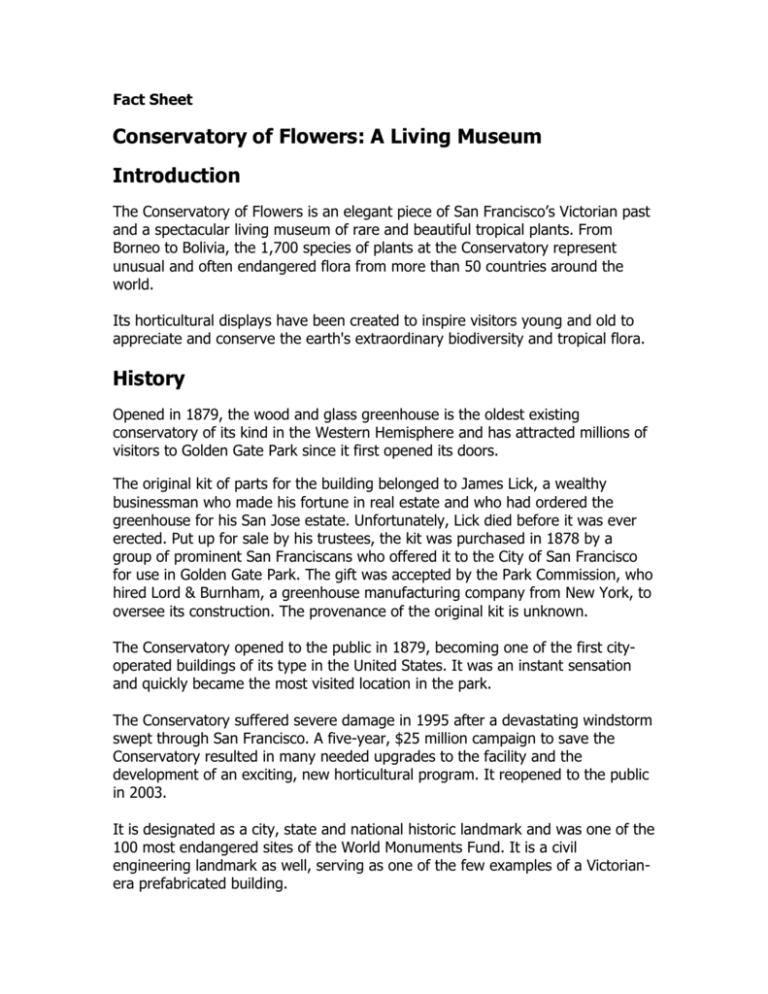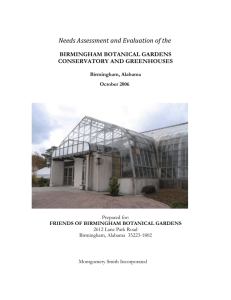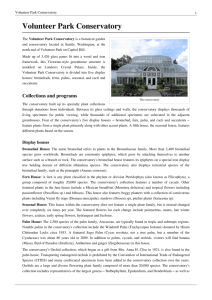Fact Sheet - Conservatory of Flowers
advertisement

Fact Sheet Conservatory of Flowers: A Living Museum Introduction The Conservatory of Flowers is an elegant piece of San Francisco’s Victorian past and a spectacular living museum of rare and beautiful tropical plants. From Borneo to Bolivia, the 1,700 species of plants at the Conservatory represent unusual and often endangered flora from more than 50 countries around the world. Its horticultural displays have been created to inspire visitors young and old to appreciate and conserve the earth's extraordinary biodiversity and tropical flora. History Opened in 1879, the wood and glass greenhouse is the oldest existing conservatory of its kind in the Western Hemisphere and has attracted millions of visitors to Golden Gate Park since it first opened its doors. The original kit of parts for the building belonged to James Lick, a wealthy businessman who made his fortune in real estate and who had ordered the greenhouse for his San Jose estate. Unfortunately, Lick died before it was ever erected. Put up for sale by his trustees, the kit was purchased in 1878 by a group of prominent San Franciscans who offered it to the City of San Francisco for use in Golden Gate Park. The gift was accepted by the Park Commission, who hired Lord & Burnham, a greenhouse manufacturing company from New York, to oversee its construction. The provenance of the original kit is unknown. The Conservatory opened to the public in 1879, becoming one of the first cityoperated buildings of its type in the United States. It was an instant sensation and quickly became the most visited location in the park. The Conservatory suffered severe damage in 1995 after a devastating windstorm swept through San Francisco. A five-year, $25 million campaign to save the Conservatory resulted in many needed upgrades to the facility and the development of an exciting, new horticultural program. It reopened to the public in 2003. It is designated as a city, state and national historic landmark and was one of the 100 most endangered sites of the World Monuments Fund. It is a civil engineering landmark as well, serving as one of the few examples of a Victorianera prefabricated building. Horticultural displays Immersive displays in five galleries include the lowland tropics, highland tropics, aquatic plants, potted plants and special exhibits. The Conservatory is one of only four public institutions in the United States to house a highland tropics exhibit. Lowland Tropics Lowland Tropics is a steamy jungle of plants that are native to the low-lying forests of countries such as Mexico, Brazil, Indonesia, Vietnam, Madagascar, Senegal and more. Here, the Conservatory features a wide variety of economic plants in order to educate the public about the tropical products they eat and use in the home every day. Visitors can marvel at chocolate, coffee and other favorites "in the wild." Other plants in this gallery include the Conservatory's centenarians, the oldest and most valuable plants in the entire collection. They include: Dioon spinulosum and Zamia lindenii--Two varieties of cycads: Cycads are primitive gymnosperms that first appear in the geological record about 170 to 180 million years ago. They were present before the rise of dinosaurs and persist today in limited areas of the world. Philodendron speciosum--Imperial philodendron: A native of southeastern Brazil, this is the largest specimen in cultivation and is more than 100 years old. It appears for the first time in printed inventories accompanying the Park Commissioners' Report in 1901-1902. Phoenix roebelinii--Pygmy date palm: This plant came to the Conservatory after the 1915 Panama-Pacific International Exposition. It is native to Laos and is widely cultivated as an ornamental. The trunk takes on a characteristic curving nature with age. Highland Tropics The Highland Tropics room provides an intimate glimpse of the life in the mountain forests of the tropics and is home to one of only four public collections in the United States of highland tropical plants. A primary feature of the Highland Tropics room is the Conservatory's large and renowned collection of high-altitude orchids (pleurothallids). It is home to more than 700 of the 1,000 known species, making it the largest and most comprehensive public collection in the world. These plants are native to midelevations in Central and South America, where the temperatures are very similar to San Francisco, including the prevalence of fog. Of particular note are the Conservatory's Dracula orchids. These orchids did not originally get their name from the classic Hollywood monster, but from the Greek word for 'little dragon' due to this flower's distinct face-like markings and unusual hinged lip. Other important plants featured in this gallery are: Bromeliads: These plants are cousins of the pineapple and Spanish moss. Many of them grow attached to trees or rocks, extracting water from humid or misty air and nutrients from debris that gathers around their roots and from the rain. Vireya rhododendrons: Vireya rhododendrons account for approximately onethird of all rhododendron species. Native to Southeast Asia, these lovely flowering plants are found at all elevations, but primarily grow in the cool mountains. The vireya rhododendron was introduced in England in 1845 and soon became enormously popular with Victorian collectors. Aquatic Plants Aquatic Plants features the Conservatory's beautiful cascading pools full of the striking plants that crowd the waterways of the tropics. The two primary ponds are maintained at different temperatures. The upper pool is warmer to support a community of lowland species. The other is cooler for the species of the highlands. It was at the Conservatory of Flowers that a special plant made its North American debut in the 1880s.Victoria amazonica, a giant amongst lilies, was such a hit that it is now a common feature of most aquatic plant displays in the nation's outdoor ponds. It is, however, still uncommon to see in conservatories. These phenomenal giant water lilies are native to the Amazon River and southern Brazil. Their leaves can grow to six feet in diameter and can support the weight of a small child. The undersides of the leaves and entire surface of the petioles and bracts surrounding the flower petals are laden with sharp spines that protect the plants from marauders. This gallery also features a collection of carnivorous plants including Nepenthes, the Asian pitcher plant family. Asian pitcher plants are the only carnivorous plants that vine. Their alluring tube-like pitchers secrete a fluid rich in enzymes that lure unsuspecting critters in. The pitcher plant then digests (dissolves) whatever snacks fall in. Potted Plants Throughout its history, the Conservatory has presented special floral displays and gorgeous holiday spectacles. Potted Plants extends that tradition and celebrates the seasons with an ever-changing display of vibrant and fragrant blooms. In this gallery, visitors can always find a lovely assortment of tropical favorites to suit the season such as hibiscus, begonias, coleus and more. In addition to these, several interesting vines and trees are permanently displayed here. This gallery also features an incredible assortment of decorative urns and containers from all over the world including a large travertine-plaster urn that is a legacy of San Francisco's 1915 Panama-Pacific International Exposition. Visitors can sit on a historic bench under the arbor and admire the profusion of color and the lovely containers. Potted Plants pays homage to the Conservatory's Victorian roots, re-creating a historical development termed by garden historians "Victorian Pot Culture." In Victorian glasshouses, visitors encountered a diversity of potted plants displayed on benches, allowing people to stop and admire one interesting flower or plant after another. Special Exhibits Special Exhibits features an ever-changing program of special exhibitions and horticultural displays. Past exhibitions have included The Butterfly Zone, Nature's Pharmacy: The Healing Power of Plants, The Modern Art of Orchids, One: An Earth Installation by Stanlee Gatti, Chomp: Carnivorous Plants, and Color: A Winter Carnivale. Integrated pest management The San Francisco Recreation and Park Department has led the nation in reducing pesticide use in municipal parks. In step with this city initiative, the Conservatory maintains a population of geckos that live within the building to reduce pests. Beneficial insects are also released into the Conservatory's galleries to keep harmful species in check.











